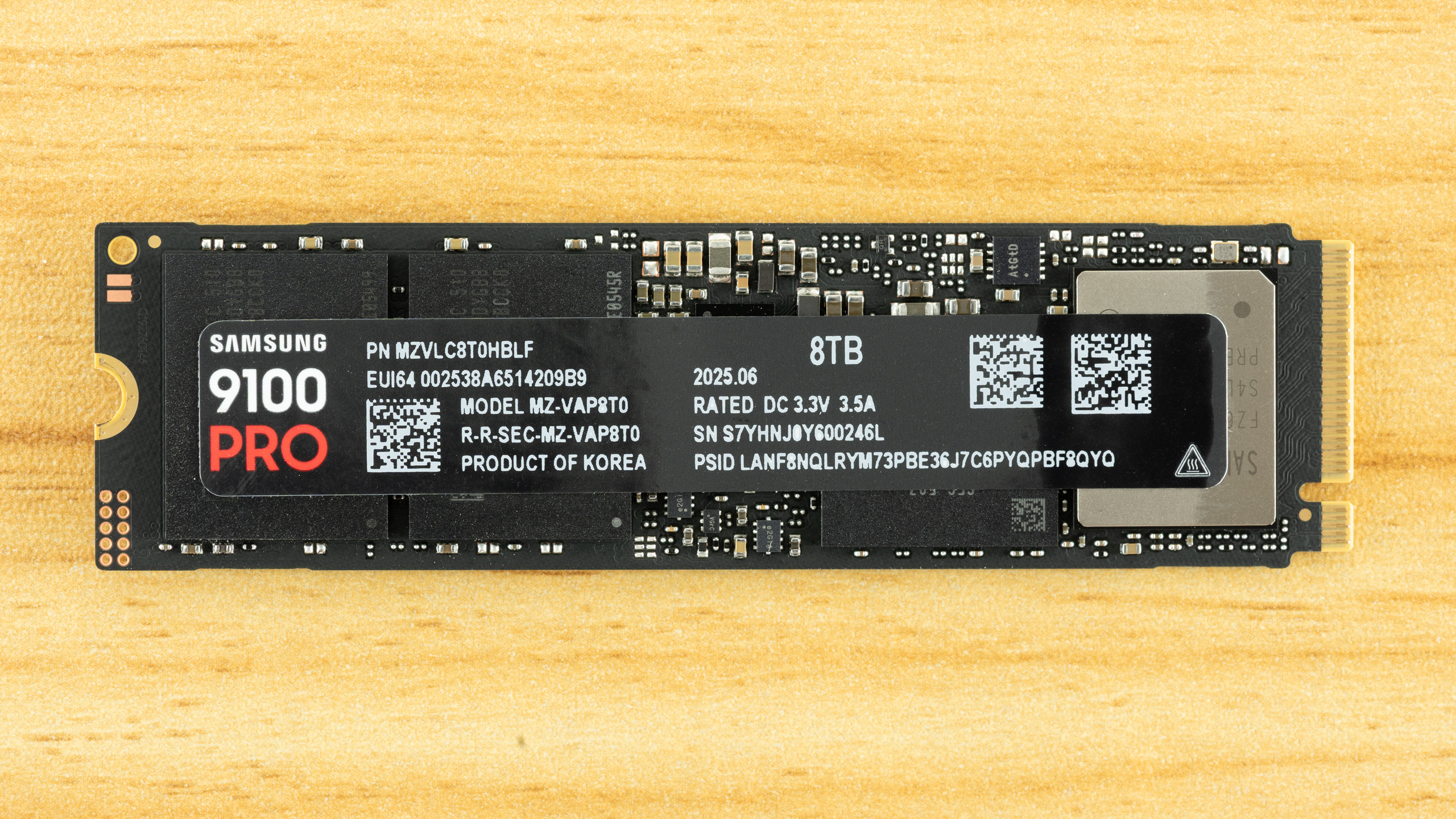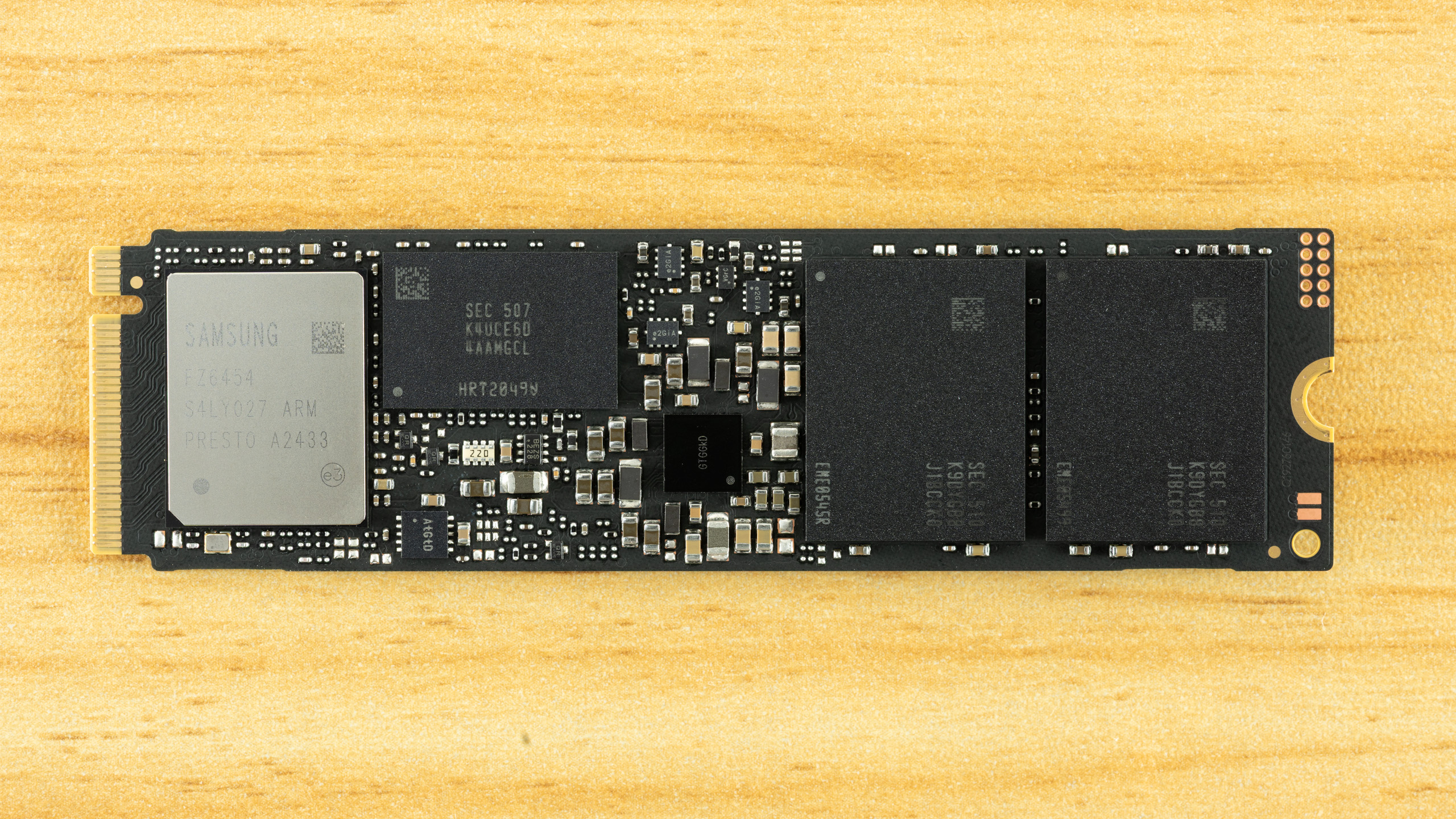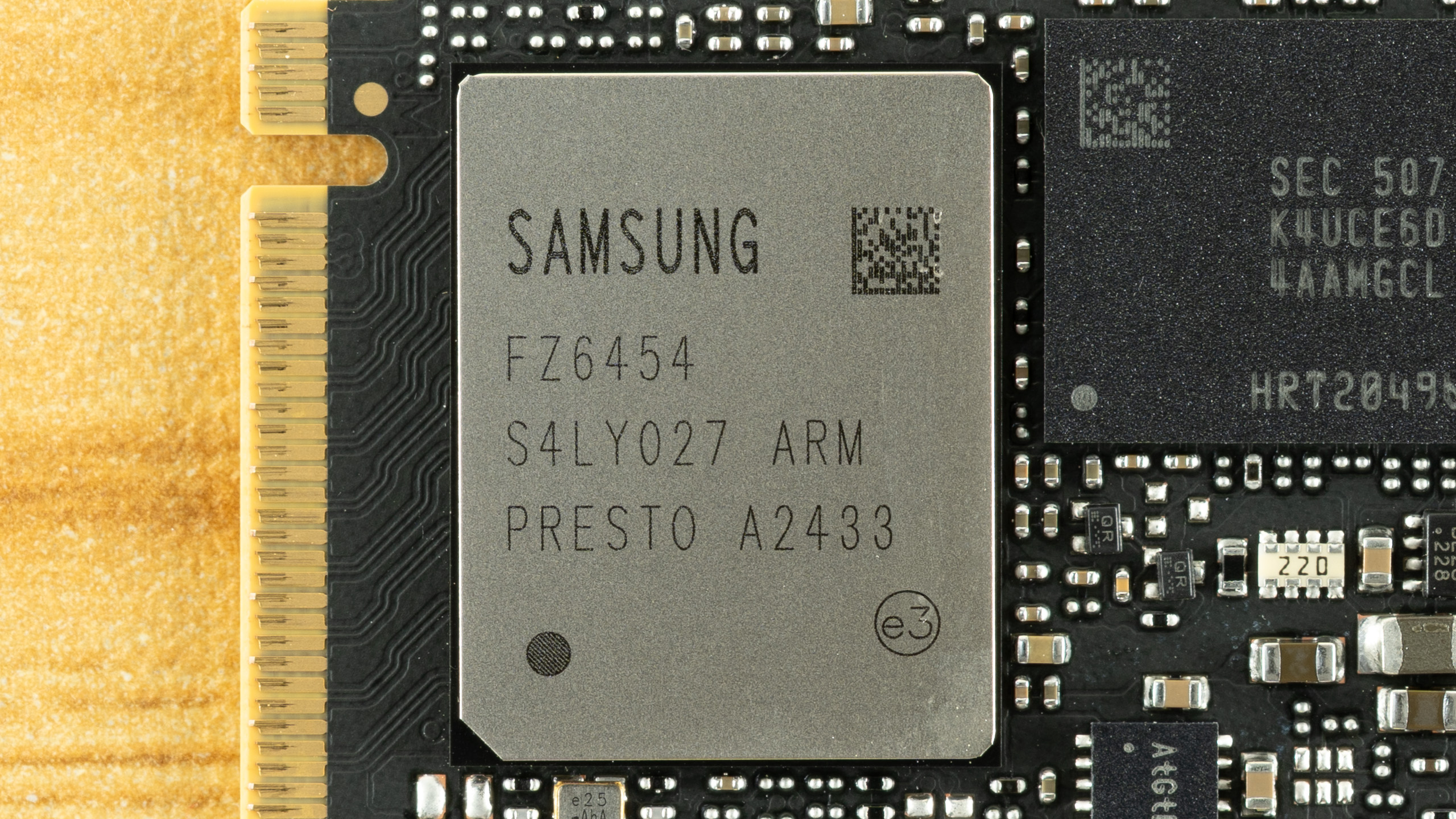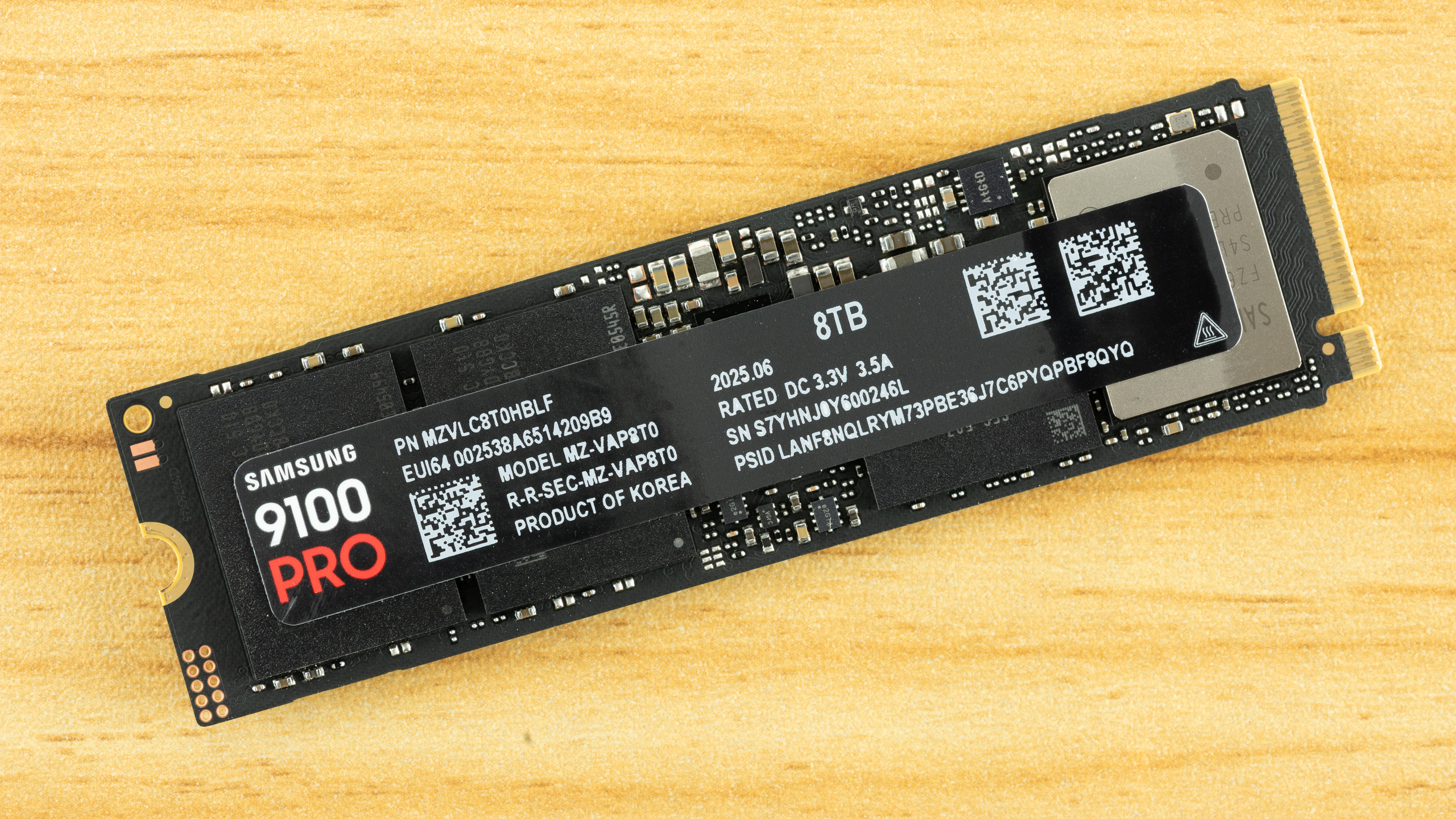Tom's Hardware Verdict
The Samsung 9100 Pro 8TB pushes the limit with the first large capacity, high-end Gen 5 drive. It delivers, but at a high price.
Pros
- +
8TB capacity
- +
High-end PCIe 5.0 performance
- +
Samsung name and support
Cons
- -
Very high MSRP
- -
Not the fastest drive
Why you can trust Tom's Hardware
In response to Phison’s early and near-total dominance of the high-end PCIe 5.0 SSD market, Samsung came, saw, and…well, tried to put up a good fight with its 9100 Pro. Samsung did a lot of the same things right that it had with the 990 Pro, which was itself a fitting successor to the popular 980 Pro, by producing a fast, efficient, and consistent drive. Only one thing was missing: a high-capacity 8TB SKU designed not only to answer the Black SN850X but to take back the initiative while using the newest flagship hardware.
Samsung is no pushover. Its high-quality flash has great random read latency, something everyone desires, and the company knows how to produce a drive that, at the very least, holds its own in every other metric. The 9100 Pro isn’t the fastest drive, but it is more efficient than any of the high-end SSDs that came before it, and it performed well enough to stay in the fight. It was perhaps a little late to the party, but it has been competitive, especially with Samsung’s aggressive pricing, and we’ve only recently reviewed drives that truly improve upon it.
The shifting situation has forced Samsung to adapt in ways it didn’t have to back in the PCIe 3.0 days. For one, Samsung has priced the 9100 Pro more aggressively as we just suggested above. This works in its favor due to its superior brand recognition, even if there is some dilution. The name still sells, but perhaps not as well as it did in the past, which is why the discount is necessary. Samsung has had various issues with the 980 Pro, 990 Pro, and other drives in recent years, and this has tarnished the brand. Secondly, Samsung has begun to emphasize capacity more, with the 4TB 990 Pro release being an excellent example. Samsung introduced a new flash generation with that release – that flash is now used on the smaller SKUs as well – and released the best 4TB drive we had tested to date. It’s still our recommended PCIe 4.0 drive. So far, so good.
The problem with the 9100 Pro was, in part, that we had already tasted the Micron 4600. We knew that the upcoming SMI SM2508 controller could do amazing things, and the later-arriving Sandisk WD_Black SN8100 proved that even more strongly by coupling the controller with BiCS8 TLC flash and optimized firmware. WD, prior to this, had also released the 8TB WD Black SN850X, which claimed the throne as the best high-capacity drive on the market. The 9100 Pro needed a boost, and Samsung decided it was ready to take a step it might not have taken in the past by releasing the 8TB version of the drive. It was even willing to take the risk of releasing a double-sided monster of a drive, and that is the beast we have before us today.
Samsung 9100 Pro Specifications
Product | 1TB | 2TB | 4TB | 8TB |
|---|---|---|---|---|
Pricing (Bare) Heatsink | ||||
Form Factor | M.2 2280 | M.2 2280 | M.2 2280 | M.2 2280 |
Interface / Protocol | PCIe 5.0 x4 / NVMe 2.0 | PCIe 5.0 x4 / NVMe 2.0 | PCIe 5.0 x4 / NVMe 2.0 | PCIe 5.0 x4 / NVMe 2.0 |
Controller | Samsung Proprietary (Presto) | Samsung Proprietary (Presto) | Samsung Proprietary (Presto) | Samsung Proprietary (Presto) |
DRAM | LPDDR4X | LPDDR4X | LPDDR4X | LPDDR4X |
Flash Memory | 236-Layer Samsung TLC (V8) | 236-Layer Samsung TLC (V8) | 236-Layer Samsung TLC (V8) | 236-Layer Samsung TLC (V8) |
Sequential Read | 14,700 MB/s | 14,700 MB/s | 14,800 MB/s | 14,800 MB/s |
Sequential Write | 13,300 MB/s | 13,400 MB/s | 13,400 MB/s | 13,400 MB/s |
Random Read | 1,850K | 1,850K | 2,200K | 2,200K |
Random Write | 2,600K | 2,600K | 2,600K | 2,600K |
Security | TCG Opal 2.0 | TCG Opal 2.0 | TCG Opal 2.0 | TCG Opal 2.0 |
Dimensions Bare | 80.15 (L) x 22.15 (W) x 2.38 (H) mm | 80.15 (L) x 22.15 (W) x 2.38 (H) mm | 80.15 (L) x 22.15 (W) x 2.38 (H) mm | 80.15 (L) x 22.15 (W) x 3.88 (H) mm |
Dimensions w/HS | 80.15 (L) x 25 (W) x 8.88 (H) mm | 80.15 (L) x 25 (W) x 8.88 (H) mm | 80.15 (L) x 25 (W) x 8.88 (H) mm | 80.15 (L) x 25 (W) x 11.25 (H) mm |
Endurance (TBW) | 600TB | 1,200TB | 2,400TB | 4,800TB |
Part Number | MZ-VAP1T0 | MZ-VAP2T0 | MZ-VAP4T0 | MZ-VAP8T0 |
Warranty | 5-Year | 5-Year | 5-Year | 5-Year |
Samsung always planned an 8TB SKU for the 9100 Pro, which is why we had the specifications already outlined in our original review. Performance at 8TB peaks at up to 14,800 / 13,400 MB/s for sequential reads and writes, with the ability to handle up to 2,200K / 2,600K random read and write IOPS. The warranty remains at five years with up to 600TB of writes per TB of capacity, and the drive still supports encryption. The only thing we didn’t know before was the price, and Samsung has now put the MSRP at $999.99 for the base drive with another $20 for the heatsink. This level of pricing requires some discussion of its own.
Our table has revised and current pricing for the smaller SKUs, which, unsurprisingly, show much lower prices than the MSRPs from our original review. In the introduction, we discussed how Samsung had to be more aggressive with pricing, given the 9100 Pro's market position, and this is reflected in the relatively large price swings. While the MSRP on the 8TB SKU may seem high, it’s actually reasonable given the original pricing. Even with the new pricing, it’s only 25% higher per TB than the 2TB and 4TB SKUs, which isn’t a ridiculous premium when you consider there isn't a competing high-end PCIe 5.0 drive at 8TB right now, and Samsung had to make a double-sided drive with dense flash packages just to make this work.
Does that justify the MSRP? The presence of the 8TB WD Black SN850X, which has been priced very effectively, makes this a harder sell. Yes, you have Gen 5 bandwidth with the 9100 Pro, but you could almost buy two SN850Xs at its price if you consider the lowest sale price we’ve seen for the latter. In our opinion, the 8TB 9100 Pro can command this level of MSRP given Samsung’s name and the fact that the competition is still pushing 8TB back on their roadmaps. We also think Samsung can and will discount this to some extent. So if you’re the type of person who wants the very best right now, you can probably manage the launch pricing. If not, some patience will likely pay off. Otherwise, we still recommend the SN850X, which is a no-brainer at 8TB as far as we’re concerned.
Get Tom's Hardware's best news and in-depth reviews, straight to your inbox.
Samsung 9100 Pro Software and Accessories
Samsung continues to offer a download for its Magician software, an all-in-one SSD toolbox that remains the industry gold standard. WD’s Dashboard is also quite good, but not everyone cares about having an SSD toolbox. This type of application is handy for checking drive health and system information, S.M.A.R.T. readings, and more.
Diagnostics and benchmarking are often included, and a toolbox is essential for getting firmware updates or engaging/disengaging drive features. Finally, the best toolboxes – and Magician falls into this category – offer imaging and backup options for your storage. There are free alternatives for this, but this is one of those rare cases where we think the manufacturer’s software gets the job done.
Samsung 9100 Pro: A Closer Look


The 8TB 9100 Pro is a double-sided drive with four NAND flash packages. Samsung is forced to go double-sided for this SKU, as the controller and LPDDR4X DRAM occupy considerable real estate. The 236-Layer V8 TLC flash being used is manufactured in dense, 1 TB dies. This means there are sixteen dies per 2TB package, which is an incredible amount of flash to stack. Technically, thirty-two die stacks are now possible, but the yields are poor, and such die density is in high demand for enterprise applications. Samsung has, for quite some time, only delivered single-sided drives, so this departure emphasizes just how strong its desire is to be the first to 8TB.
Sixteen die packages (16DP) have long been the realistic maximum in the consumer space, but it’s much more typical to see eight or octal die packages (8DP) even for high-capacity drives. This is because it is challenging to achieve high yields and maintain acceptable signal integrity with sixteen dies, especially at the higher bus and I/O rates required for the very fastest drives. Samsung uses custom F-Chips inside the flash packages for retiming and control, but we’ve seen external multiplexors used by Crucial in the 4TB T500 and 2TB P510 to help with signal integrity. Depending on the solution, different costs are added as a drawback to reach high capacities with newer, faster flash, so the price premium for this drive is warranted in at least this respect.
The drive being double-sided does mean that some devices will have trouble fitting it, but we don’t think this is necessarily a big deal. The 9100 Pro is a high-end PCIe 5.0 drive, which has limited application in a laptop and other mobile devices, most of which still rock PCIe 4.0 M.2 slots. It will probably work fine in that reduced state, and besides, the 990 EVO Plus and its OEM counterpart already fill that role quite well.
We often say that double-sided drives can be trickier to effectively cool, but Samsung has understood the assignment: the 8TB 9100 Pro’s heatsink is designed for double-sided application, given its increased dimensions. We would recommend this high-capacity drive for desktop use, and the heatsink is an easy $20 addition. If you're already dropping nearly $999 for the drive, a $20 upcharge is trivial.



For more detailed and technical explanations of this controller and flash we recommend reading our original 9100 Pro and 4TB 990 Pro reviews, respectively. To provide a succinct analysis, Samsung’s Presto controller on paper overwhelms the early-adopter Phison E26, but faces stronger challenges from the newer Phison E28 and SMI SM2508. These newer controllers are more efficient and can achieve higher performance levels. That said, we remain a fan of Samsung’s complex but polished controller technology as it is highly consistent and mature. Problems that arose with the last generation of drives do remain in the minds of many, however, so perhaps some caution is warranted.
As for the flash, we remain positive about the 236-Layer V8 TLC from Samsung. It was a compromise of somewhat higher random read latency from the last generation in return for benefits in throughput and improved yields. It’s still high-quality flash that is, frankly, the way to go if you seek the highest endurance – overlooking the unfortunate issues with older flash and firmware on the 980 and 990 Pros. We think Samsung has learned from these setbacks and applied the lessons not only to the 9100 Pro but to the 8TB SKU in particular. The internal strategy appears to be to return to form in any way possible.
MORE: Best SSDs
MORE: Best External SSDs
MORE: Best SSD for the Steam Deck
- 1
- 2
Current page: Samsung 9100 Pro Features and Specifications
Next Page Samsung 9100 Pro 8TB Performance Results
Shane Downing is a Freelance Reviewer for Tom’s Hardware US, covering consumer storage hardware.
-
JayGau Reply
What? I've got a 990 Pro 4Tb almost two years ago.closs.sebastien said:finally samsung goes > 2 tb ... the magician did some miracle.. -
Stomx With its 600 TB written per each 1 TB size, which means its P/E endurance is even less than 600 cycles, this and mostly all other TLC SSDs on the market were not made to last if some best QLC already reach endurance 3000Reply
Am I too wrong to expect ( based on the well known scaling of endurance with number of bits per cell which drops by an order of magnitude from SLC to MLC to TLC to QLC ) that if QLC reach 3,000 P/E cycles, some best TLC ones have to be in the 30,000 range not 600? -
Jame5 Did samsung magician ever get support for setting 4kn block sizes rather than continuing on with 512e?Reply -
Stomx By the way is it safe to use Sansung SSDs on Linux if it's Magician software is not supported on Linux?Reply -
bit_user Concerning idle power:Reply
I just have to confirm that you waited for it to be truly idle. In my experience, this is best accomplished by watching the controller temperature and checking that it drops almost back to whatever it was, before you started writing to it. If you check immediately after writing a bunch of data, the drive will still be consolidating the data, and thus won't be truly idle.
Second, would you please try measuring PCIe 5.0 drives in 4.0 mode? I had asked this before, and Jarred even agreed before he left. Even if you don't repeat the full suite of benchmarks in PCIe 4.0 mode, at least giving us the power data would be very helpful for those of us who only have a PCIe 4.0-compatible M.2 slot! -
JayGau Reply
You don't need the software. It's a nice tool, but it's absolutely not mandatory. I have a 990 Pro in my PC and I haven't even reinstalled Magician after I did a Windows fresh install a few months ago (I didn't think about it and the drive works just fine).Stomx said:By the way is it safe to use Sansung SSDs on Linux if it's Magician software is not supported on Linux? -
bit_user Reply
Well, if it's using 512-byte sectors, then they probably account for more write amplification than those QLC drives.Stomx said:With its 600 TB written per each 1 TB size, which means its P/E endurance is even less than 600 cycles, this and mostly all other TLC SSDs on the market were not made to last if some best QLC already reach endurance 3000
I don't recall a TLC drive with such endurance. You could look at a mixed-workload datacenter drive, like the Solidigm D7-P5520 (which I have), and its endurance of 7000 TBW for 3.84 TB capacity. That's a ratio of 1823. If you go up to a SLC drive, like the D7-P5810, the 800 GB capacity has 73,000 TBW, which is a ratio of 91250. So, there's a more recent data point for you about what's possible with SLC.Stomx said:Am I too wrong to expect ( based on the well known scaling of endurance with number of bits per cell which drops by an order of magnitude from SLC to MLC to TLC to QLC ) that if QLC reach 3,000 P/E cycles, some best TLC ones have to be in the 30,000 range not 600?
Which QLC drive are you claiming has a TBW:TB ratio of 3k?
Yes, of course. The Magician software is just a tool for querying and configuring the drive. Don't confuse it with the device driver.Stomx said:By the way is it safe to use Sansung SSDs on Linux if it's Magician software is not supported on Linux?
Lots of people use Samsung Pro NVMe SSDs in Linux (including myself, although it's the 990 Pro). At the end of the day, it's just a NVMe drive and it implements the NVMe standard. -
bit_user Reply
The 990 Pro only advertises support for 512-byte sectors, even with the latest firmware. I have no idea about the 9100 Pro, but if it's not advertising support for 4k sectors, it's going to need a firmware update and not simply a change at the "Magician" level.Jame5 said:Did samsung magician ever get support for setting 4kn block sizes rather than continuing on with 512e?
Unless Samsung has promised 4k sector support, I'd guess it's not coming for this drive. I don't see why they'd add it, so late after launch.
BTW, my Samsung PM9A3 came formatted with 512-byte sectors, but I was able to reformat it to use 4k sectors (which I did in Linux: nvme format /dev/nvme0n1 --block-size=4096). Sadly, I didn't benchmark it before the change, and now it's got data on it so I'm not switching it back. However, that's a somewhat recent example of a Samsung NVMe drive supporting both formats.
